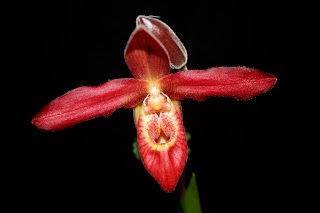



This past weekend I had the opportunity to buy some orchids, the first in a couple months. Actually, it was a pair of opportunities. AOS judge Betty Berthiaume donated her entire collection of some 10 000 plants to the Orchid Species Preservation Foundation in Edmonton. The Foundation pulled from the donation what they needed for their collection, and the rest are being sold to the general public - still thousands of plants! Thus I visited the Muttart Conservatory on the weekend to attend the sale. I picked up a number of plants, all at incredibly reasonable prices. One of those plants was in bloom and is pictured above - the first photo - Bulbophyllum lepidum. This, together with the Bulbo. leptanthum that I acquired at the sale, are the first two Bulbos to grace my collection. They are very interesting plants. Bulbo. lepidum is also known as Cirrhopetalum lepidum, and is furthermore known also by the specific epithet andersonii for either genus. Such is but a taste of the confusion that plagues the genus of Bulbophyllum, which is the largest genus in Orchidaceae with some 2000 species - all quite different yet similar - and those species have been variously placed into different genera by different taxonomists over the years. But I'll go off on that tangent some other day.
The other plants pictured here I purchased at the OSA September meeting, the next day. They are, from top to bottom: Doritaenopsis Kenneth Schubert, Phragmipedium (Taurus x schlimii 'Nad'), and Phrag besseae ('Haven' x 'Smokin').
Dtps. Kenneth Schubert is a rather famous Phal hybrid because of its floriferous spikes of blue-violet flowers that fade to pale lavender - uncommon colors for Phals and most other orchids. It is also infamous for being difficult to grow. The previous owner of the plant told me that they like higher light than other Phals, and that is the trick. I guess we'll find out!
The Phrag schlimii cross is a pretty little miniature that I couldn't resist. Small Phrags can be tough to find. Even Phrag besseae gets quite big with age, and often, so does schlimii, which has small flowers but long leaves when mature. But hybrids with schlimii, fischeri, and the small green species like pearcei can be quite compact. As an added bonus this little guy is sweetly fragrant, a trait that none of my other Phrags share with it - even though schlimii can be fragrant (hence the fragrance in this progeny), none of my cultivars of it are fragrant in the slightest!
The besseae is an Orchid Zone cross, and anyone who knows slipper orchids knows that the Orchid Zone has some of the best examples of Paphs and Phrags out there. Terry Root's breeding sets the standard for tropical slippers, and this besseae demonstrates that. I have been hunting for a nice besseae for a long time, and I finally got one. This one was sitting next to another, inferior cultivar, also in bloom. This one has redder color, flatter and wider petals, and a larger pouch than the other one. I am excited about it - it will make a great stud plant in the future.
I joined two societies in the past week: the Orchid Species Preservation Foundation (OSPF) and the American Orchid Society. Now I am a proud member of 3 orchid societies!
In less than a week and a half I will venture to Calgary to take in the FOS' annual show and sale. I will be taking my camera!

































